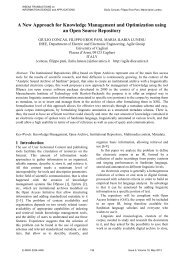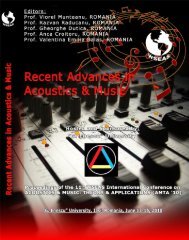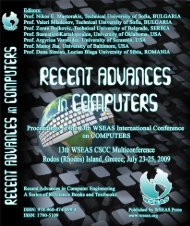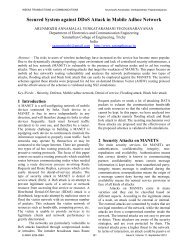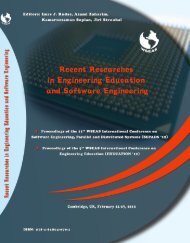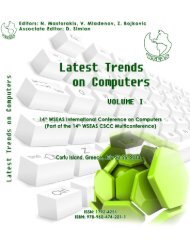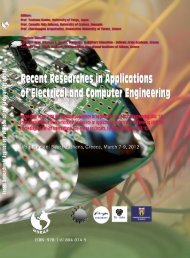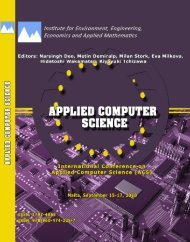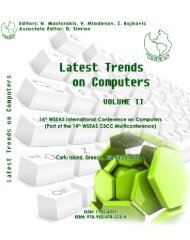Contents of this book - WSEAS
Contents of this book - WSEAS
Contents of this book - WSEAS
Create successful ePaper yourself
Turn your PDF publications into a flip-book with our unique Google optimized e-Paper software.
Mathematical Methods for Information Science and Economics<br />
Plenary Lecture 5<br />
Robust Video Object Detection and Tracking Techniques<br />
Pr<strong>of</strong>essor Tudor Barbu<br />
Institute <strong>of</strong> Computer Science<br />
Romanian Academy, Iasi branch<br />
Romania<br />
E-mail: tudbar@iit.tuiasi.ro<br />
Abstract: Video object detection and tracking represents an important computer vision domain that has been vividly<br />
researched in the last decades. It has promising applications in numerous important fields, such as video<br />
compression, video surveillance, human-computer interaction, video indexing and retrieval, medical imaging, traffic<br />
monitoring, augmented reality and robotics. Obviously, it consists <strong>of</strong> two closely related processes. The first one,<br />
video object detection involves locating an image object in theframes <strong>of</strong> a video sequence, while the second one,<br />
video tracking, represents the process <strong>of</strong>monitoring the video object spatial and temporal changes during the<br />
moviesequence, including its presence, position, size and shape.While an object detection algorithm identifies image<br />
objects in video frames, an object tracking procedure must solve the temporal correspondence problem that is the<br />
task <strong>of</strong> matching the target object in successive frames.<br />
Numerous video detection and tracking technologies have been developed inrecent years. Object detection can be<br />
performed through various approaches, such as:region-based image segmentation, background subtraction,<br />
temporaldifferencing, active contour modelsand the generalized Hough transforms.Video tracking techniques are<br />
based on Kalman filtering, Hidden Markov Models, optical flow, template matching, mean-shift trackingand contour<br />
tracking.Objecttracking is <strong>of</strong>ten a time consuming process due to the amount <strong>of</strong> data contained by video streams.<br />
Also, video tracking represents a difficult process, becausevarious factors such as abrupt object motion, object<br />
occlusions or camera motion. There are various types <strong>of</strong> tracking, depending on the target object character (static or<br />
moving) and the camera (fixed or moving).<br />
We approached the object detection and tracking domain in our previous works, developing some robust detection<br />
and tracking techniques for both static camera and moving camera videos. Thus, we proposed several automatic<br />
temporal-differencing based moving object detection approaches for fixed camera video sequences. The object<br />
tracking was performed using template matching and various object featuring methods. We used HOG-based,<br />
normalized cross-correlation based and 2D Gabor filtering based features for <strong>this</strong> purpose. Also, we considered video<br />
tracking approaches which are able to track successfully both the static and moving objects, in both static-camera<br />
and moving camera videos. Thus, we developed a novel semiautomatic object tracking technique based on an<br />
improved N-Step Search algorithm and a HOG-based feature extraction. Human detection and tracking, representing<br />
an important sub-domain <strong>of</strong> object detection and tracking, is also widely approached in our research.<br />
Brief Biography <strong>of</strong> the Speaker: Dr. Tudor Barbu is currently Senior Researcher II at the Institute <strong>of</strong> Computer<br />
Science <strong>of</strong> the Romanian Academy, in Iasi, Romania. He is the coordinator <strong>of</strong> the Image and Video Processing and<br />
Analysis research collective <strong>of</strong> the institute and also member <strong>of</strong> the leading Scientific Council <strong>of</strong> <strong>this</strong> institute. Mr.<br />
Barbu has a PhD degree in Computer Science, awarded by the Faculty <strong>of</strong> Automatic Control and Computers <strong>of</strong> the<br />
University “Politehnica” <strong>of</strong> Bucharest.<br />
He has a remarkable research pr<strong>of</strong>ile. In the last decade he published two <strong>book</strong>s and four <strong>book</strong> chapters as single or<br />
main author. Also, dr. Tudor Barbu published more than 65 articles in prestigious international journals and volumes<br />
<strong>of</strong> international scientific events (conferences, symposiums and workshops). His prolific scientific activity also<br />
includes more than 35 research reports, elaborated with the institute research team coordinated by him or related to<br />
various research projects. His scientific publications have got over 70 citations, according to Google-Academic.<br />
In recent years he also coordinated various research directions in 6 projects based on contracts/grants. Dr. Tudor<br />
Barbu received also several awards for his research results, the most important being the Romanian Academy Prize<br />
“Gheorghe Cartianu”, in the Information Science and Technology domain, awarded on December 18, 2008. He is<br />
member <strong>of</strong> several conference scientific committees and also member <strong>of</strong> scientific and technical committee and<br />
editorial review boards <strong>of</strong> some journals. He is the Editor in Chief <strong>of</strong> a <strong>book</strong>. His main scientific areas <strong>of</strong> interest are:<br />
digital media (audio, video and image) signal processing and analysis, pattern recognition, computer vision,<br />
multimedia information storage, indexing and retrieval, and biometric authentication using voice, face and digital<br />
fingerprint recognition.<br />
ISBN: 978-1-61804-148-7 18




